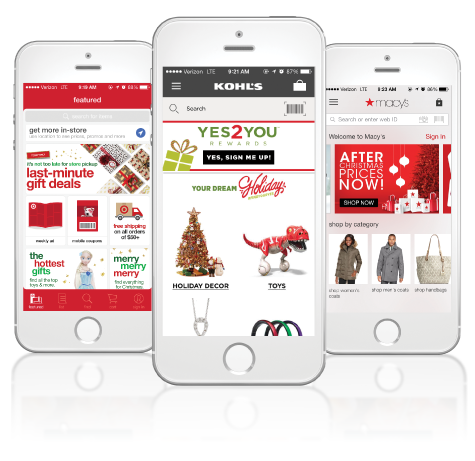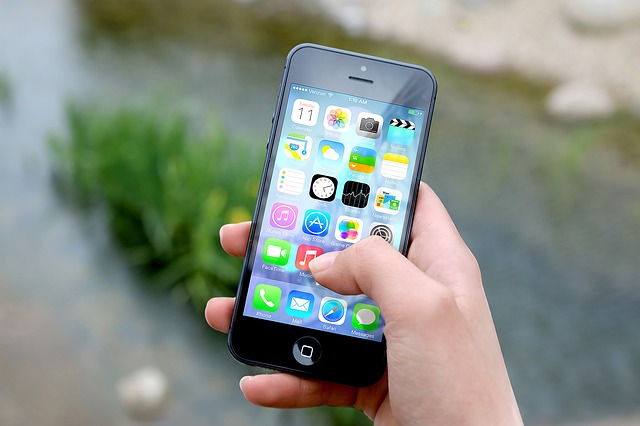According to the IBM U.S. Retail Black Friday Report, smartphones and tablets accounted for 52.1% of all online traffic on Thanksgiving, which exceeded traditional PC’s for the first time. This recent statistic is evidence of the growing influence of mobile technology on shoppers, and this trend is expected to continue its rapid growth. The benefits of mobile as a marketing and customer engagement platform are abundant for businesses, allowing an unparalleled level of personalization and targeting based on a variety of factors. Consumers are targeted based on demographics, geolocation, social interests, and even time of day. Mobile apps across the retail, food service, and grocery segments, specifically, offer an interesting comparison across their respective industries as to how they are used to engage and retain customers.
Retail: In-Store Experience Meets Online Convenience
The goal for many retailer mobile apps is to connect the in-store shopping experience with the convenience and benefits of shopping online. Mega-retailers Walmart and Target offer store-mapping features allowing shoppers to navigate the store and locate items by aisle number, as well as display the price of the item. Walmart takes things a step further with its Savings Catcher feature, which automatically searches for and compares competitors’ prices on certain items.
Retail apps often look to create a competitive advantage through customer engagement. Both Kohl’s and Macy’s mobile apps offer mobile wallets that provide loyalty members the opportunity to redeem special offers in-store. Macy’s targets tech-savvy millennials with a feature that allows shoppers to take pictures of items they like, and search for similar items on Macys.com.

Restaurants: Mobile Ordering Attracts Millennials
Restaurant mobile apps are also heavily geared towards millennials, and emphasize and encourage decision making on-the-go. These are most popular within the fast food and fast-casual chain segments. The most common feature is mobile ordering, which chains such as Chick-Fil-A, Starbucks, and Taco Bell all either offer or plan to offer. Mobile ordering allows customers to order ahead of time and pay via smartphone, then pick up the order in-store. Outback Steakhouse offers a similar level of convenience through a different strategy, with a mobile reservations tool. This enables customers to see wait times for every Outback location throughout the country, and allows customers to add their names to a current wait list, as well as remove them with no penalty.
After realizing that customers are willing to spend more and come back more often when they can order online, Domino's became the first major fast food chain to offer a mobile voice-ordering service, adding to their existing mobile efforts.
Grocery: Customers Rewarded for Loyalty
Though grocery mobile apps don’t quite match the capabilities of popular retail or food service apps, they add an extra level of convenience for shoppers. Kroger, the largest grocery chain in the United States, offers a free mobile app that provides electronic coupons and shopping lists, as well as prescription refilling capability through the Kroger pharmacy. Kroger, as well as Safeway, also offers access to customer loyalty programs via mobile app. Safeway, in particular, is known for its “Just for U” customer loyalty program, which offers personalized discounts based on customers previous purchases. Safeway’s app also includes a grocery delivery option, as well as the capability to scan barcodes in-store to check for coupons.
What’s Next?
The bottom line is that every organization competing in today’s environment must be continually refining a mobile strategy to better serve their customers. Many innovative approaches to leveraging this technology will continue to shape the interactions that customers have with these brands.
Leveraging the power and momentum of mobile strategies, TrendSource recently released aAmplify as a mobile research solution designed to capture valuable real-time insights from store customers. Customers are incentivized to assess aspects of the store operation, providing customer satisfaction and service delivery insights via mobile device as they roam store aisles and interact with employees. With aAmplify, operators are able to gain a greater understanding of what is happening in their stores at any given moment. Not only does this strengthen engagement with customers, but it provides operators and researchers with a cost-effective way to generate valuable data to improve service delivery.

